Section 1
Transport Appraisal
November 2015
Transport Scotland
Once printed or downloaded this document is considered to be uncontrolled. For the current version refer to the Scot-TAG section of the Transport Scotland website.
Version History
Changes since STAG Refresh, May 2008
|
Change number |
Section updated |
Date |
|
1 |
Typographical errors and formatting |
December 2013 |
|
2 |
Referencing, “Guidance on the development of business cases in Transport Scotland” and some changes to terminology |
November 2015 |
Contents
Scottish Transport Appraisal Guidance
1.1 Introduction
1.1.1 What is the Guidance
1.1.2 When to use STAG
1.1.3 What are the Key Concepts in STAG
1.1.4 How do the phases of STAG fit together
1.1.5 Why Participation and Consultation is important
1.1.6 What should be Reported
1.1.7 Integrity and Audit
1.2 History of STAG
Scottish Transport Appraisal Guidance
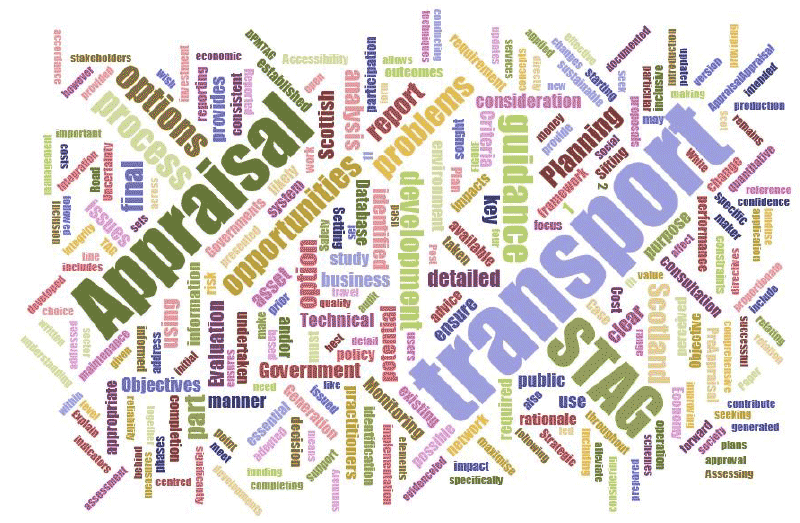
The Scottish Transport Appraisal Guidance (STAG) provides a comprehensive source of advice on all aspects of the transport planning process from the earliest stages of transport planning, through Appraisal and implementation to ex-post evaluation.
This Technical Database sets out in detail the methodology and reporting structure to be followed when conducting a Transport Appraisal in accordance with STAG. It supplements the Guidance document, which provides a high-level overview of the Appraisal process. This Technical Database has been written specifically for practitioners who are conducting a transport Appraisal. It is not intended to be read by those involved in transport or development planning at a higher level and who wish to develop an understanding of STAG; instead they are referred to the Guidance document in addition to Development Planning and Management Transport Appraisal Guidance (DPMTAG)1.
The environment for transport Appraisal is constantly changing, and this Technical Database will be updated regularly to reflect this. Updates are issued to registered Scot‑TAG users; registration is available at Scottish Transport Analysis Guide (Scot-TAG).
The Scottish Government’s Purpose is to ‘focus the Government and public sector services on creating a more successful country, with opportunities for all of Scotland to flourish, through increasing sustainable economic growth’. The Scottish Transport Appraisal Guidance (STAG) supports the Government’s Purpose by allowing the contribution that can be made by potential transport interventions to be presented in a clear, consistent manner.
The Government’s particular transport purpose is to focus investment on making connections across and with Scotland better, improving reliability and journey times, seeking to maximise the opportunities for employment, business, leisure and tourism. Additionally, to provide sustainable, integrated and cost effective public transport alternatives to private car, connecting people, places and work, across Scotland.
Transport is one of Scotland’s most vital public amenities, influencing amongst others, the economy, communities, environment, and quality of life. A transport system that serves Scotland well is fundamental to achieving the Scottish Government’s vision of a prosperous, inclusive and sustainable society.
STAG ensures that potential options to address evidenced based transport problems are identified and appraised in a consistent manner and that such options will contribute to the Scottish Government’ Purpose and meet the transport needs of Scotland .
It is a requirement that an Appraisal using STAG is undertaken by commissioning authorities and their agents when seeking Government funding, support or approval for proposals to significantly change the transport system.
The completion of a study, as documented in a final report, allows the rationale behind a potential transport options to be presented in a clear, evidence-led manner and provides the information required by a decision maker to make an informed choice of the most appropriate options for design development.
STAG provides a process and framework for consistent appraisal of generated options which could potentially address identified problems and opportunities against a range of criteria, including value for money. By completing an Appraisal in accordance with STAG, final report provides the Strategic Business Case for options taken forward.
The completion of an Appraisal in line with STAG and the production of the final report should precede any application for planning consent or the production of development management Transport Assessments in support of developments. This ensures appropriate consideration and reporting of the transport issues relative to the proposal being developed. To this extent an Appraisal is complementary to a Transport Assessment. If an Appraisal of the impact of development plans is being undertaken, DPMTAG would be the appropriate reference.
An Appraisal using STAG is required when Government funding, support or approval is sought for justified proposals to change the transport system. Its use is encouraged in other circumstances when there is a need for changes to the transport system and may be applied to issues including:
- Considering public transport and road network coverage;
- Assessing measures to improve the reliability of the road network;
- Assessing issues in relation to the safety of the transport network;
- Access to services; and
- Land-use development.
The Guidance can be used to identify transport options to address identified or perceived problems or opportunities relating to a range of transport planning scenarios. The transport options may include but need not be limited to:
- Cycling and walking improvements;
- Public transport – rail, bus or other;
- Road schemes; and
- The development of transport and/or plans, policies and strategies.
STAG should not be adopted when considering issues relating to maintenance or renewal which will not significantly change an existing asset or impact upon the operation of this asset. However, it must be adopted when there is likely to be:
- The creation of a new asset
- A significant enhancement to an existing asset; or
- Any change to an existing asset which will materially impact upon the operation of the existing asset.
An Appraisal using STAG is not required for network maintenance schemes which replace the layout of an existing asset broadly like for like and do not directly affect the operation of this asset.
All Appraisals using STAG must encompass the principles of being objective-led rather than solution-led, present the Appraisal of options against the Transport Planning Objectives, STAG Criteria and established policy directives and include proposals for Monitoring and Evaluation. The STAG Process should, however, be applied proportionately to the impacts of the issue under consideration. Help and advice is available from Transport Scotland on this frequently misunderstood point to ensure that the Appraisal presents the information required by the decision maker in a timely manner that also represents value for money.
Practitioners should establish the clear rationale for using the STAG Process prior to starting a STAG led study. This will ensure that STAG is the appropriate tool for the study under consideration. This Technical Database outlines detailed guidance to aid practitioners in completing the scoping exercise. Advice should be sought from Transport Scotland if practitioners require further clarity on the purpose for which they wish to use the Guidance.
1.1.3 What are the Key Concepts in STAG
There are a number of key concepts which underpin the Guidance:
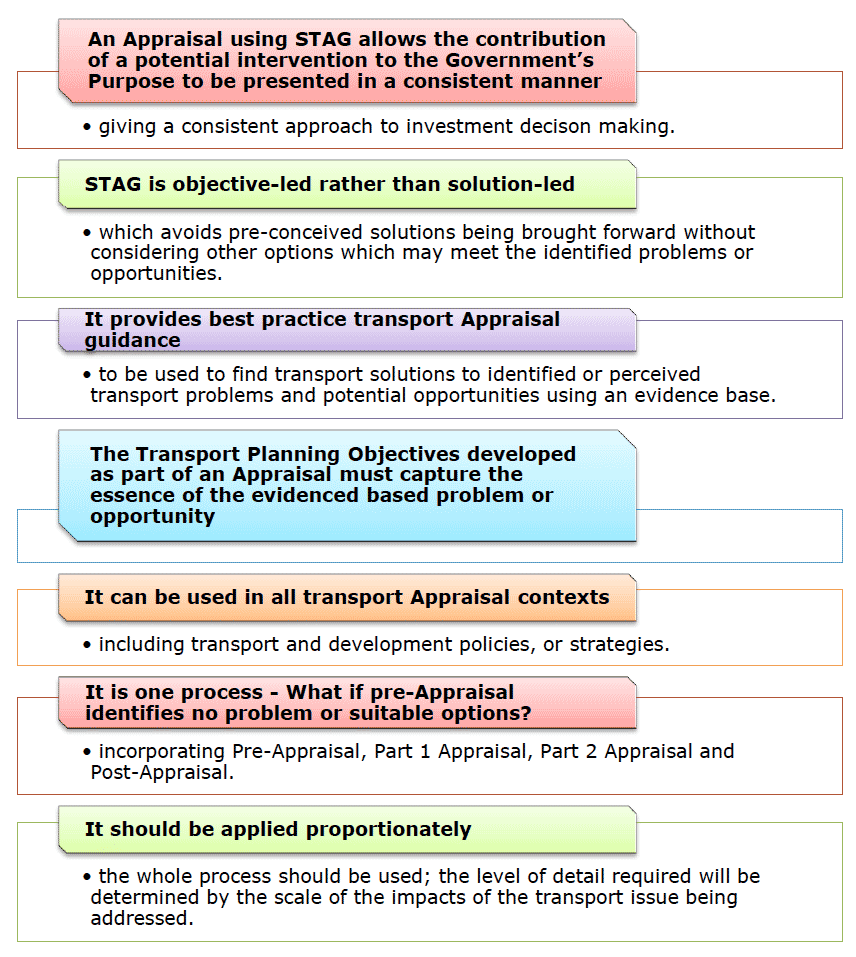
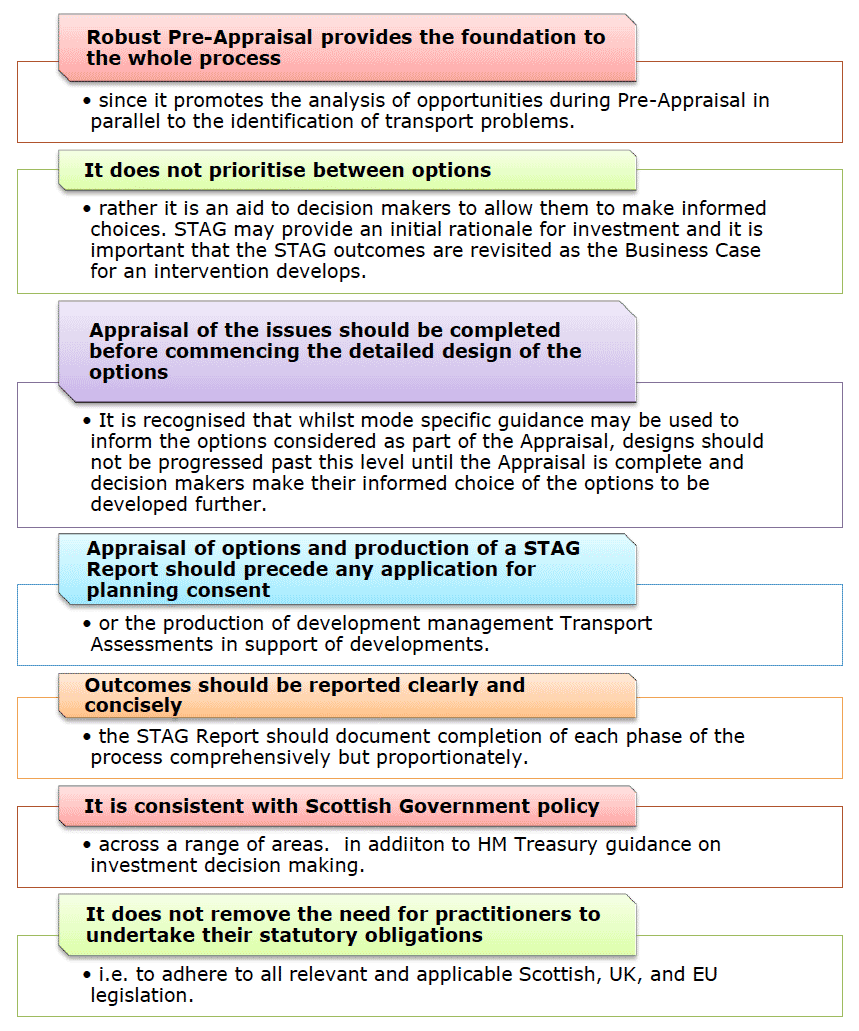
1.1.4 How do the phases of STAG fit together
There are four key phases to the STAG transport appraisal process as shown in Figure 1.1.
These four phases should be viewed as continuous, from Pre-Appraisal (Analysis of Problems or Opportunities, Objective Setting and Option Generation, Sifting and Development) through to Part 1 Appraisal (initial qualitative appraisal). Those options which are not rejected in Part 1 are subjected to detailed quantitative appraisal in Part 2. Monitoring and Evaluation, the components of Post Appraisal should be recognised throughout the Appraisal.
FIGURE 1.1 – The STAG Process
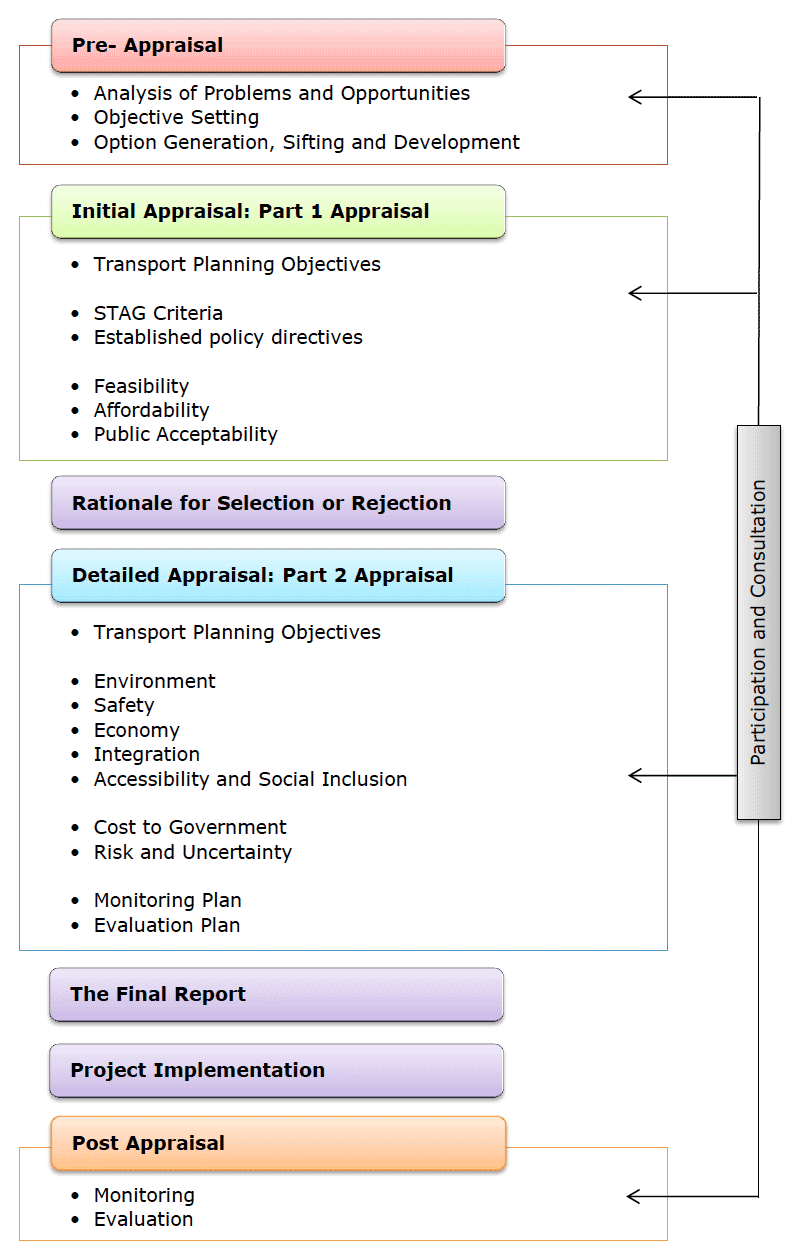

The Pre-Appraisal process is the essential starting point and sets the rationale for undertaking an Appraisal in accordance with STAG. It includes the key tasks of:
- Analysis of Problems, Issues, Constraints and Opportunities;
- Objective Setting; and
- Option Generation, Sifting and Development.
Analysis of Problems, Issues, Constraints and Opportunities
Identified or perceived problems or potential opportunities with the transport system are the essential starting point for any Appraisal.
The identification of problems should be accompanied by a full analysis of the opportunities available and supported by an understanding of the issues and constraints which are likely to affect the chances of any transport option meeting Transport Planning Objectives and alleviating identified transport problems.
Objective Setting
Transport Planning Objectives should express the outcomes sought for the study under consideration.
Option Generation, Sifting and Development
The generation of options should be based on the widest possible set of potential options which could alleviate the identified or perceived problems, or potential opportunities.
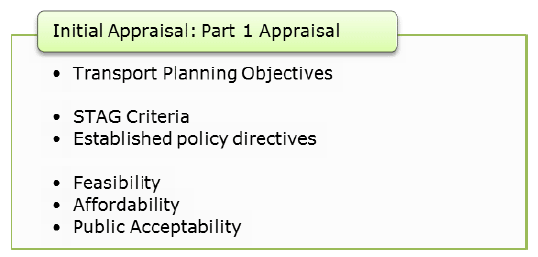
An initial Appraisal of all options generated during Pre-Appraisal with specific consideration given to:
- Is the option going to alleviate the identified or perceived transport problems and/or maximise potential opportunities?
- Is the option consistent with the established policy directives?
- Is the option likely to meet the Transport Planning Objectives?
- What are the likely impacts against the STAG Criteria?
- Is the option likely to be: acceptable to the public, affordable and feasible to construct and operate?
- Is there a clear rationale for the rejection of options on completion of Part 1 Appraisal?
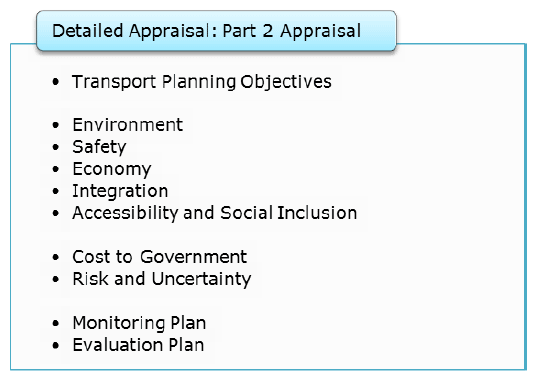
Detailed Appraisal of the options which have been taken forward from Part 1 Appraisal with specific consideration given to:
Transport Planning Objectives
A detailed Appraisal of options against the Transport Planning Objectives using quantitative techniques and analysis.
STAG Criteria
A detailed Appraisal of options against the STAG Criteria (Environment, Safety, Economy, Integration and Accessibility) using quantitative techniques and analysis. In this guidance, accessibility has been extended to make particular reference to social inclusion issues.
Cost to Government
A detailed analysis of the total public sector cost of options, including investment costs, operating and maintenance costs and grant/subsidy payments.
Risk and Uncertainty
A detailed analysis of the risk and uncertainty associated with each option.
The successful completion of an Appraisal, as documented in the final report, allows the rationale behind a potential transport intervention to be presented in a clear, evidence-led manner and provides the information required by a decision maker to make an informed choice.
An Appraisal using STAG provides the Strategic Business Case for the options taken forward, and the foundations for the Strategic and Socio-economic elements of an Outline Business Case. Further information on the Business Case process within Transport Scotland can be found in Guidance on the development of business cases in Transport Scotland.
All reporting to the Scottish Government and/or Transport Scotland must be in the form of a final report which must be structured in line with the STAG:
- Introduction;
- Analysis of Problems and Opportunities;
- Objective Setting
- Option Generation, Sifting and Development;
- Part 1 Appraisal;
- Part 2 Appraisal;
- Cost to Government;
- Risk and Uncertainty;
- Option Summary Table;
- Monitoring Plan;
- Evaluation Plan; and
- Conclusions.

If an option is implemented and investment committed then it is essential that the project is monitored and evaluated to assess performance against the Transport Planning Objectives established within an Appraisal, the STAG Criteria and any additional impacts identified during the Appraisal.
Monitoring
It is a requirement that, prior to implementation, a clear Monitoring Plan is prepared as part of an Appraisal and reported in the final report. Monitoring is a continuing process, involving information gathering and interpretation, to ensure that Key Performance Indicators (KPIs), developed to measure progress towards a set of agreed targets, are being met.
Evaluation
The term Evaluation is used to describe a specific one-off activity designed to investigate performance and causes in depth. Evaluation also uses performance indicators and measures. It is a requirement that, prior to implementation, a clear Evaluation Plan is prepared as part of an Appraisal and reported in the final report.
1.1.5 Why Participation and Consultation is important
Participation and consultation are key elements of an Appraisal and should ensure that the interests of stakeholders are considered in an inclusive, open, transparent and appropriate manner.
In order for participation and consultation to be effective and contribute positively to the identification and analysis of transport problems and opportunities, it is essential that the following best practice participation and consultation attributes are adopted:
- Explain the STAG process, avoiding the use of technical terminology where possible;
- Explain roles and responsibilities, encouraging shared ownership of the work being undertaken;
- Be open so that those taking part understand the process and can see how their views are being taken into account;
- Be proportionate in relation to the identification of the transport problems to be addressed and the transport opportunities to be undertaken;
- Start as early as possible in the process and continue throughout to maximise stakeholder confidence in the process as it develops and to reach consensus, as far as possible, on outcomes;
- Involve stakeholders both in the identification of problems and opportunities and the development and assessment of solutions; and
- Provide feedback to contributors wherever possible.
The final report is the means through which practitioners communicate the Appraisal work undertaken: it should be written in a manner which will inform the decision making process. A final report should provide a concise summary demonstrating that the process of STAG has been followed and the Guidance adhered to.
To seek to ensure that the final report is comprehensive and proportionate, reporting guidance is provided throughout the Guidance, supplemented, where necessary, with the detailed advice provided in this Technical Database.
At the end of each section there is a list of key points which practitioners must use to ensure they are following the process as intended whilst assembling sufficient information to be included in the final report.
This Technical Database includes detailed guidance on the requirement for integrity checks. The level of detail required will be determined by the type and size of the transport study under consideration and specifically the transport problems being addressed and/or transport impacts being assessed.
The Scottish Government and/or its agency Transport Scotland may seek a review or audit of Appraisal using STAG where further confidence in the application of the process and/or outcomes is sought.
The STAG framework arose directly from the July 1998 transport White Paper, Travel Choices for Scotland, which established the new policy framework for transport in Scotland. The White Paper heralded important developments in policy with a clear focus on three key aims:
- A strong economy;
- A clean environment; and
- An inclusive society.
The draft version of STAG was issued for use and consultation in 2001 with the final version published for use in September 2003. The guidance was then subsequently updated and launched on ‘Scot‑TAG’, a web based platform, in November 2005.
The Guidance was refreshed in 2008 and changes since then have been issued as “business as usual” updates to ensure it remains fit for purpose, is informed by the latest and best available evidence and is available in an accessible form.
The guidance remains centred on providing a transport appraisal process framework which is centred on outcomes against the five STAG Criteria, namely:
- Environment (maximising the quality of the built and natural environment for enjoyment by all);
- Safety (reducing the risk and incidence of accidents and improving the security of all transport users);
- Economy (saving people’s and business’s time and money and facilitating desired economic development);
- Integration (fitting the transport network together and ensuring a rational relationship between transport and land-use and wider policy);
- Accessibility and Social Inclusion (providing everyone, not just users but also non-users, with the means to travel to opportunities of all kinds).
1. Development Planning and Management Transport Appraisal Guidance (DPMTAG)